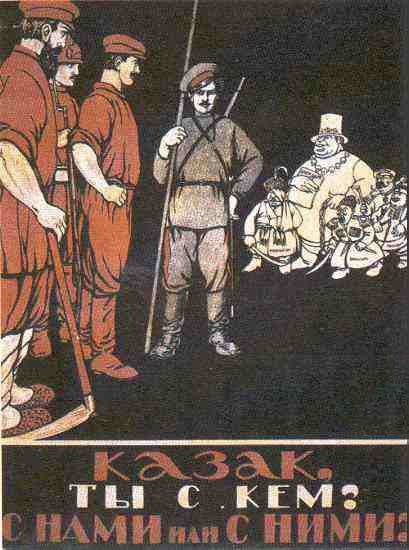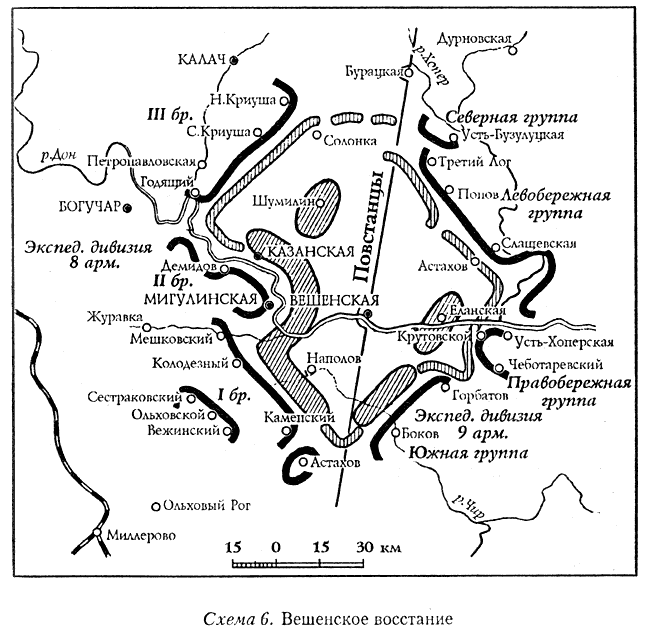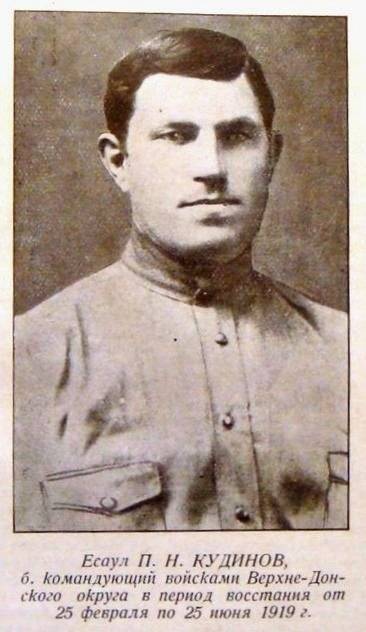Verkhniyon uprising
Split the Cossacks. Storytelling
The attitude of the Bolsheviks to the Cossacks was ambivalent. On the one hand, negative, as the Cossacks were considered "executioners, guardsmen, dead men" of the fallen royal regime. The Cossacks were a privileged class, had land and privileges. At the same time, the Cossacks were professional military men, well trained, organized, and with their weaponsthat is, represented a threat. On the other hand, the Cossacks wanted to win over, since they were a special part of the peasantry. They could be used in the fight against the enemies of the Soviet regime.
The Cossacks themselves also hesitated; there was a split in their ranks in relation to the Soviet power. Initially, the bulk of the Cossacks, especially the young, front-line soldiers, were on the side of the Bolsheviks. They supported the first decrees, returned to peaceful life, nobody touched their land. The Cossacks believed that they could maintain neutrality and would not interfere in the war between white and red. That the repressive policy of the Bolsheviks was directed only against the rich classes - the bourgeoisie, landowners, etc. At the same time, some Cossacks had strong separatist moods that they could live separately and richly, avoid common collapse and chaos, war. They wanted to spit on a “united and indivisible” Russia, they became active separatists. It is clear that in the conditions of the general Russian distemper it was a utopia that cost the Cossacks very expensive.
As a result, the Cossacks became "grass on the battlefield." Kaledin, Alekseev and Denikins opposed the Bolsheviks, while the majority of the Cossacks on the Don were neutral. White and White Cossack were beaten. Volunteers retreated to the Kuban. Kaledin died. Don region occupied red. Among them were many red Cossacks under the command of a military foreman Golubov.
It is worth remembering that during the unrest up come various dark, asocial and criminal personalities. They use general chaos, anarchy, collapse to rob, kill, satisfy their dark needs. There is a criminal revolution. Bandits and criminals "repaint" in red, white, nationalists, to gain power, to use it in their own interests. In addition, many revolutionaries, the Red Guards, sincerely hated the Cossacks, the “royal guardsmen”.
Therefore, when the Reds occupied the Don region, it was automatically considered a hostile, enemy territory. Various negative excesses began to occur - red terror, repression, murder, unreasonable arrests, robberies, requisition, the seizure of elements of the control system, the land by aliens. Punitive expedition.
All this caused the active resistance of the Cossacks, who were the military class, that is, they knew how to fight. On this wave was created Cossack republic Krasnov. At the same time, she was hostile to the Russian civilization, to the people, as it was oriented toward the West, Germany. Krasnov asked the German emperor to help in the dismemberment of Russia and the creation of a separate state - the Great Don Army. Krasnov also claimed the neighboring cities and regions - Taganrog, Kamyshin, Tsaritsyn and Voronezh. Krasnov also supported the "separatism" of other parts of Russia - Ukraine-Little Russia, Astrakhan, Kuban and Terek Cossack troops, the North Caucasus. The course on "independence" led to the collapse of Russia. Krasnovtsy declared themselves "separate" from the Russian ethnic group. That is, half of the population of the Don Region (Russians, but not Cossacks) were removed from management, their rights were infringed, they were people of the “second class”.
No wonder that Cossacks also split. There was no united front of the Cossacks against the Bolsheviks. So, despite all the excesses, 1918 Cossack regiments fought on the side of the Red Army in the middle of 14, and among the Cossacks were such talented red commanders as Mironov, Blinov, Dumenko (from Don peasants). BUT Krasnov's government arranged its raskazachivanie - red Cossacks, in order to eliminate supporters of the red power in the Don. Sympathizers of the Soviet government were expelled from the Cossacks, deprived of all rights and privileges, taken land and property, expelled from the Don region, or sent to penal servitude. All the red Cossacks, who joined the Red Army and were captured, were executed. The policy of "white" raskazachivaniya underwent up to 30 thousand. Red Cossacks with their families. In total, during the policy of the Reds from May 1918 to February 1919, according to various estimates, thousands of Cossacks, supporters of Soviet power on the Don, were destroyed from 25 to 45.
It is also worth remembering that the White Cossacks, who fought in the armies of Krasnov and then Denikin, behaved in the neighboring provinces, in particular, in the Saratov and Voronezh gubernias, as foreign enemies. White and Cossacks were not knights without fear and reproach. They were "products" of decomposition, death of the Russian Empire. The Cossacks were participants in the White Terror. The Cossack units were robbed, raped, killed, hanged and flogged. Huge transports followed the Cossack regiments; the Cossacks plundered Russian villages as if they were walking not in Russia, but in a foreign land. In Denikin’s memoirs, they look like a gang of marauders, not “warriors of Holy Russia.” Russian citizens and peasants who were “liberated” from Soviet power were robbed, raped and killed. The Cossacks also acted against their own peasants, "non-resident" in the territory of the Don region. It is clear that it all caused a hard answer, when the flywheel of the terrible civil war turned back and the Don Army collapsed, began to retreat. The spontaneous response of the Red Guards, the Red Army turned into revenge, too, to all the Cossacks, indiscriminately.
You also need to know that in the leadership of the Bolshevik Party there was a wing of cosmopolitan internationalists, agents of the influence of the West. They led to the cause of the collapse, the destruction of Russian civilization, the "world revolution" on the basis of the death of Russia. The Cossacks, personified the ancient Russian traditions of the soldiers-tillers, caused their hatred. Trotsky and Sverdlov initiated the process of storytelling. Trotsky wrote about the Cossacks:
Trotsky demanded that the Cossacks arrange a Carthage.
In January, 1919, the chairman of the All-Russian Central Executive Committee, Yakov Sverdlov, signed a directive on disclosure. Tops of the Cossacks, the rich Cossacks were subject to total destruction, the terror was used against those who took any part in the fight against the Soviet regime; introduced the policy of surplus; in the Cossack region settled newcomer poor; carried out complete disarmament, shooting everyone who did not surrender their weapons; to prevent new uprisings, they took hostages from prominent representatives of the stanitsas. When the Voshensky Uprising began, these instructions were supplemented by the requirements of mass terror, with the burning of the insurgent villages, the merciless executions of the rebels and their accomplices, the mass taking of hostages; mass resettlement of the Cossacks into Russia, replacing it with a new element, etc. A little later, when the uprising began, the Soviet leadership recognized the fallacy of a number of revolutionary events. So, March 16 1919 was held with a plenum of the Central Committee of the RCP (b) with the participation of Lenin, who decided to suspend the planned measures of merciless terror "in relation to all Cossacks in general who took any direct or indirect participation in the fight against Soviet power."

Verkhniyon uprising
The first wave of terror and robbery passed through the Don, when the Cossacks themselves opened the front and went home. Red troops entered the Don, they requisitioned horses, food, spontaneously allowed the enemies of the Soviet regime (or who seemed to be such) to the “expense”. Killed first officers. Then the regular red troops settled on the bank of the Seversky Donets, the front stabilized.
Organized rasskazachivanie was much worse. Commissar Fomin was replaced in February 1919 by the uprising against Krasnov. Among the representatives of the new government there were many revolutionaries-internationalists. The cossack regiments that had gone over to the side of the Reds were sent to the Eastern Front. Began mobilization, now the Cossacks persecuted to fight for the Reds. The red Cossack commander Mironov was removed far away (he later spoke out against the policy of disclosing and Trotsky). After that began a full-scale raskazachivanie. The very word "Cossack", the Cossack form, was forbidden, weapons were withdrawn, for non-delivery - execution. The villages were renamed in the parish, farms in the village. Verkhne-Donskoy district was liquidated, Vyoshensky district was created instead. The property of the rich and the bourgeois was seized. Settlements obkladyvali contribution. Some of the Don lands were planned to be divided into the Voronezh and Saratov regions, they were going to be settled by newcomers. In some places, they began to liberate land for immigrants from the central provinces.
Terror and repression were not spontaneous, but well organized, systematic. Any “accomplice” could have come under attack, and not just officers, gendarmes, chieftains, priests, etc. And a split took place in many families, one son, a brother could fight for the whites, another for the Reds. But it turned out that the family was "counter-revolutionary."
The Cossacks could not stand it and rebelled again. The spontaneous uprising began in March 1919. Immediately rebelled in several places. The Cossacks of the three farms drove the Reds out of Vyoshenskaya. The rebellion raised five villages - Kazan, Elanskaya, Vyoshenskaya, Migulinskaya and Shumilinskaya. Khutor formed hundreds, elected commanders. Spent a full mobilization of all those who could carry weapons. The slogan of the rebels at first was this: "For the Soviet power, but without the Communists!" It was like the program of Makhno. Chairman of the executive committee was elected military officer Danilov, commander - Khorunov Khorinov. Pavel Kudinov in the years of World War II was awarded four crosses of St. George, in 1918 he was the head of the machine gun command of the 1 th Vyoshensky cavalry regiment of the Don Army. After the uprising against Krasnov became Fomin's assistant.

Map source: A.I. Egorov. Civil war in Russia: the defeat of Denikin
March 20 1919, defeating the punitive detachment, the Vyoshensky regiment seized several guns and took Karginsky. Then the Cossacks broke another red squad and occupied Bokovskaya. Reds did not at first give the uprising a serious meaning. Weapons from the Cossacks mostly already taken away. There were a lot of similar uprisings in the country. Usually they were quickly crushed, or the rebels themselves dispersed. However, the Cossacks were a military estate, quickly organized themselves. New villages rose, practically the entire Upper Don region. Fermentation began in the neighboring districts - Ust-Medveditsk, Khopyorsk. At the beginning of the Cossack uprising there were about 15 thousand people. Kudinov reorganized the rebel army, combining the village hundreds of 5 regular cavalry divisions and one brigade and regiment. By May, Kudinov’s army already numbered about 30 thousand people.
The rebels had to repel weapons in battle. At first they fought with cold arms, swords and pikes. Then, during the battles, 6 batteries were made from captured guns, and 150 machine guns were captured. There was no ammunition, they were captured, made in a handicraft way, but they were sorely lacking. The Red Command, realizing the threat, began to remove regular regiments from the front, to enclose the region from all sides. Tightening detachments, detachments of internationalists, sailors, cadets, communists, reserve parts. In total, 25, thousands of people, were put up against the Cossacks with an overwhelming fire superiority (in May, 40, thousand soldiers, tried to suppress the uprising). The Cossacks were saved by the fact that they were underestimated, the Red troops were pulled up and entered into battle by units in different sectors, which allowed the rebels to repel attacks.
Verkhnedonskoe uprising was doomed to defeat. The rebels asked for help from the white command. However, the Don and Volunteer armies were tied up by heavy battles on the flanks — Tsaritsin and Donbass, so they could not immediately help. In March, the Eastern Front of the Don Army collapsed, the Cossacks fled to the steppe, beyond the Manych. Pala Grand Prince. The Reds forced the Manych and by the beginning of April occupied the Torgovaya, Ataman, advanced units came out to Mechetinsky. Between Don and Kuban there was a narrow, in 100 km, strip with a single branch of the railway. To stabilize the front in the east, the white command had to deploy troops from the western sector of the front, although the situation in the Donbas was also difficult. Only in May, the Don Army established contact with the rebel army with the help of airplanes. Aircraft began to bring ammunition in proportion to their weak capabilities.
In May, the Red Army, concentrating a strong strike force, began a decisive offensive. The Cossacks fought back fiercely, but there was extremely little ammunition. 22 May, the rebels began to retreat along the entire right bank of the Don. The population also ran for the Don. On the left bank of the Don Cossacks staged the last line of defense. Only the attack of Denikin’s army saved the rebels from total annihilation.
For three months, the rebel Cossacks under the command of Pavel Kudinov fought off the attacks of the 8 and 9 armies of the red Southern Front. May 25 (June 7) The rebels united with the Don Army. Over the next two weeks, through the joint efforts of the Don and the rebel armies, the entire territory of the Don Region was liberated from the Red Army. May 29 Don Army troops took Miller, June 1 - Lugansk. After that, Kudinov resigned his command. The 8-I Red Army was pushed aside to the north, on the Voronezh direction, the 9-I Red Army - to the northeast, to the Balashov direction. The rebel army was disbanded, parts of it poured into the Don Army. The White Command treated the insurgents with distrust, as they did to the former Reds, so the rebel commanders did not receive serious posts in it.
Thus, the insurgent Don Cossacks forged significant forces of the Red Army, contributing to the offensive of the White Cossacks. This allowed Denikin’s army to occupy the Don Region and create a threat of an exit to the central provinces of Russia, a strike against Orel and Tula.

Pavel Nazaryevich Kudinov, Commander of the Rebel Forces of the Upper Don District in 1919
- Alexander Samsonov
- Smoot. 1919 year
How the British created the Armed Forces of the South of Russia
How to restore Soviet power in Ukraine
How Petliurists led Little Russia to a complete catastrophe
How defeated Petliurism
Give the boundaries of 1772 of the year!
Battle for the North Caucasus. How to suppress the Terek Uprising
Battle for the North Caucasus. CH 2. December battle
Battle for the North Caucasus. CH 3. The January accident of the 11 Army
Battle for the North Caucasus. CH 4. How the 11 army died
Battle for the North Caucasus. CH 5. Capture of Kizlyar and the Terrible
Battle for the North Caucasus. CH 6. Furious assault of Vladikavkaz
How Georgia tried to seize Sochi
How the Whites crushed the Georgian invaders
The war of February and October as a confrontation between two civilization projects
How did the "Flight to the Volga"
How Kolchak's army broke through to the Volga
Catastrophe of the Don Cossacks
Information